【从入门到放弃-Java】并发编程-NIO-Channel
前言
上篇[【从入门到放弃-Java】并发编程-NIO使用]()简单介绍了nio的基础使用,本篇将深入源码分析nio中channel的实现。
简介
channel即通道,可以用来读、写数据,它是全双工的可以同时用来读写操作。这也是它与stream流的最大区别。
channel需要与buffer配合使用,channel通道的一端是buffer,一端是数据源实体,如文件、socket等。在nio中,通过channel的不同实现来处理 不同实体与数据buffer中的数据传输。
channel接口:
package java.nio.channels;
import java.io.IOException;
import java.io.Closeable;
/**
* A nexus for I/O operations.
*
* <p> A channel represents an open connection to an entity such as a hardware
* device, a file, a network socket, or a program component that is capable of
* performing one or more distinct I/O operations, for example reading or
* writing.
*
* <p> A channel is either open or closed. A channel is open upon creation,
* and once closed it remains closed. Once a channel is closed, any attempt to
* invoke an I/O operation upon it will cause a {@link ClosedChannelException}
* to be thrown. Whether or not a channel is open may be tested by invoking
* its {@link #isOpen isOpen} method.
*
* <p> Channels are, in general, intended to be safe for multithreaded access
* as described in the specifications of the interfaces and classes that extend
* and implement this interface.
*
*
* @author Mark Reinhold
* @author JSR-51 Expert Group
* @since 1.4
*/
public interface Channel extends Closeable {
/**
* Tells whether or not this channel is open.
*
* @return <tt>true</tt> if, and only if, this channel is open
*/
public boolean isOpen();
/**
* Closes this channel.
*
* <p> After a channel is closed, any further attempt to invoke I/O
* operations upon it will cause a {@link ClosedChannelException} to be
* thrown.
*
* <p> If this channel is already closed then invoking this method has no
* effect.
*
* <p> This method may be invoked at any time. If some other thread has
* already invoked it, however, then another invocation will block until
* the first invocation is complete, after which it will return without
* effect. </p>
*
* @throws IOException If an I/O error occurs
*/
public void close() throws IOException;
}
常见的channel实现有:
- FileChannel:文件读写数据通道
- SocketChannel:TCP读写网络数据通道
- ServerSocketChannel:服务端网络数据读写通道,可以监听TCP连接。对每一个新进来的连接都会创建一个SocketChannel。
- DatagramChannel:UDP读写网络数据通道
FileChannel
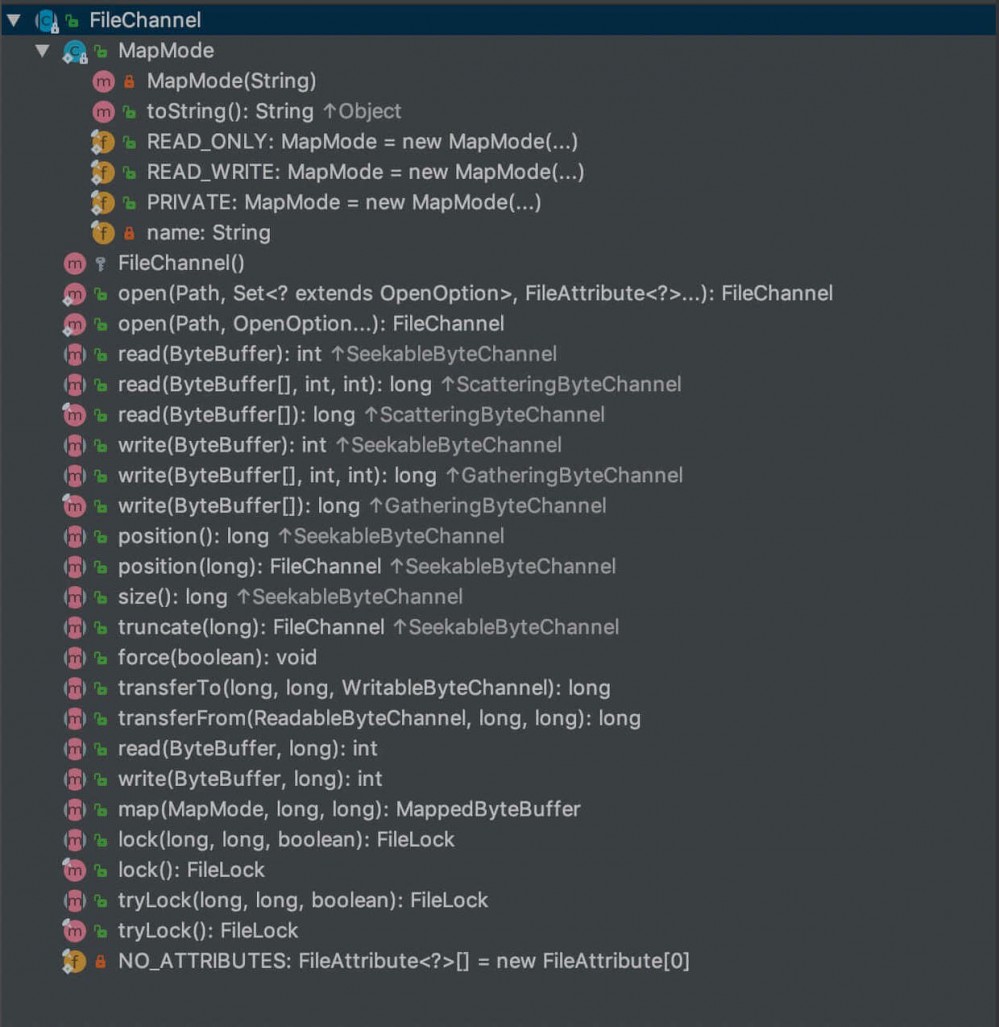
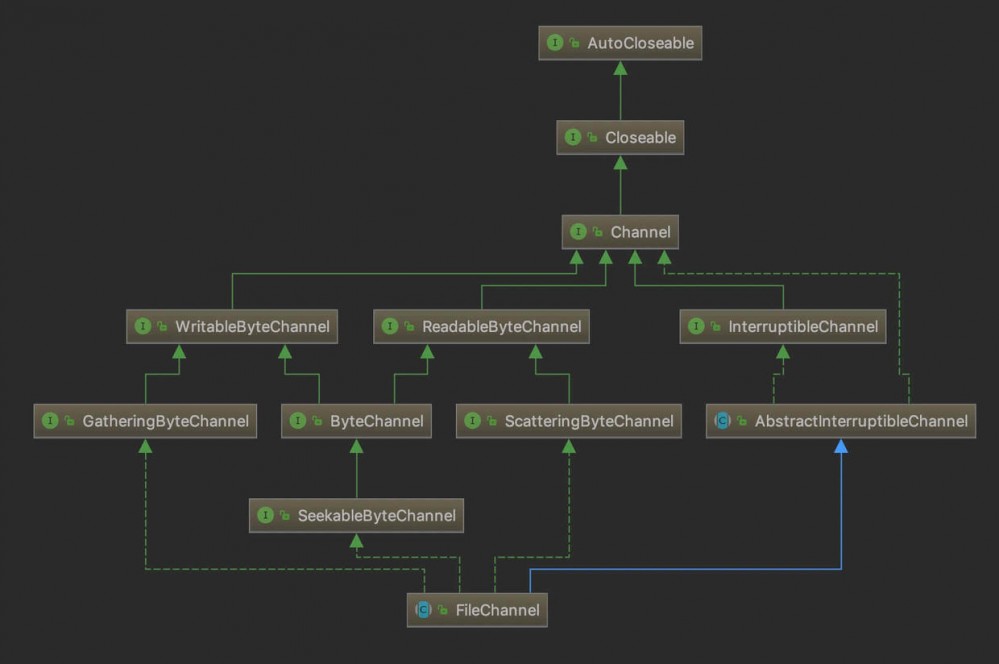
FileChannel是一个抽象类,它继承了AbstractInterruptibleChannel类,并实现了 SeekableByteChannel, GatheringByteChannel, ScatteringByteChannel接口。
具体的实现类主要是sun.nio.ch.FileChannelImpl。下面详细分析下FileChannelImpl中每个方法的具体实现。
open
private FileChannelImpl(FileDescriptor var1, String var2, boolean var3, boolean var4, boolean var5, Object var6) {
//主要记载操作系统维护的文件描述符
this.fd = var1;
//是否可读
this.readable = var3;
//是否可写
this.writable = var4;
//是否以追加的方式打开
this.append = var5;
this.parent = var6;
this.path = var2;
//底层使用native的read和write来处理文件的
this.nd = new FileDispatcherImpl(var5);
}
//FileInputStream::getChannel 调用 FileChannelImpl.open(fd, path, true, false, this) 获取只读channel
public static FileChannel open(FileDescriptor var0, String var1, boolean var2, boolean var3, Object var4) {
return new FileChannelImpl(var0, var1, var2, var3, false, var4);
}
//FileOutputStream::getChannel 调用 FileChannelImpl.open(fd, path, false, true, append, this) 获取只写channel
public static FileChannel open(FileDescriptor var0, String var1, boolean var2, boolean var3, boolean var4, Object var5) {
return new FileChannelImpl(var0, var1, var2, var3, var4, var5);
}
private FileChannelImpl(FileDescriptor fd, String path, boolean readable,
boolean writable, boolean direct, Object parent)
{
this.fd = fd;
//是否可读
this.readable = readable;
//是否可写
this.writable = writable;
//对于从流创建的channel,在结束时要做不同的清理动作,(openJDK中才有,sun的jdk中没有)
this.parent = parent;
//源文件的path
this.path = path;
//是否使用DirectIO
this.direct = direct;
this.nd = new FileDispatcherImpl();
if (direct) {
assert path != null;
this.alignment = nd.setDirectIO(fd, path);
} else {
this.alignment = -1;
}
//当parent不存在时,则注册一个cleaner,否则交由parent做清理动作。
// Register a cleaning action if and only if there is no parent
// as the parent will take care of closing the file descriptor.
// FileChannel is used by the LambdaMetaFactory so a lambda cannot
// be used here hence we use a nested class instead.
this.closer = parent != null ? null :
CleanerFactory.cleaner().register(this, new Closer(fd));
}
// Used by FileInputStream.getChannel(), FileOutputStream.getChannel
// and RandomAccessFile.getChannel()
public static FileChannel open(FileDescriptor fd, String path,
boolean readable, boolean writable,
boolean direct, Object parent)
{
return new FileChannelImpl(fd, path, readable, writable, direct, parent);
}
- open方法主要是返回一个新new的FileChannelImpl对象,初始化时设置fileDescriptor、readable、writable、append、parent、path等属性,看变量名很容易理解,在此不赘述变量含义。
read
//实现自SeekableByteChannel接口的方法,将文件中的内容读取到给定的byteBuffer中
public int read(ByteBuffer dst) throws IOException {
//保证读写时,channel处于开启状态
ensureOpen();
//判断是否可读
if (!readable)
throw new NonReadableChannelException();
synchronized (positionLock) {
if (direct)
Util.checkChannelPositionAligned(position(), alignment);
int n = 0;
int ti = -1;
try {
//开始阻塞,并注册为Interruptible,可以被中断
beginBlocking();
//将当前线程添加到NativeThreadSet中,并返回索引,方便后续操作。
//NativeThreadSet是一个线程安全的本地线程集合,方便管理,用来发送信号
ti = threads.add();
if (!isOpen())
return 0;
do {
//当未被系统中断(即读取完毕)或channel未被关闭,则一直读,将内容写入到byteBuffer(dst)中
n = IOUtil.read(fd, dst, -1, direct, alignment, nd);
} while ((n == IOStatus.INTERRUPTED) && isOpen());
return IOStatus.normalize(n);
} finally {
//把当前线程从set中移出
threads.remove(ti);
//结束,释放锁
endBlocking(n > 0);
assert IOStatus.check(n);
}
}
}
//实现自ScatteringByteChannel接口的方法,将文件中的内容依次读取到给定的byteBuffer数组中。
public long read(ByteBuffer[] dsts, int offset, int length)
throws IOException
{
if ((offset < 0) || (length < 0) || (offset > dsts.length - length))
throw new IndexOutOfBoundsException();
//保证读写时,channel处于开启状态
ensureOpen();
//判断是否可读
if (!readable)
throw new NonReadableChannelException();
synchronized (positionLock) {
if (direct)
Util.checkChannelPositionAligned(position(), alignment);
long n = 0;
int ti = -1;
try {
//开始阻塞,并注册为Interruptible,可以被中断
beginBlocking();
//将当前线程添加到NativeThreadSet中,并返回索引,方便后续操作。
//NativeThreadSet是一个线程安全的本地线程集合,方便管理,用来发送信号
ti = threads.add();
if (!isOpen())
return 0;
do {
//当未被系统中断(即读取完毕)或channel未被关闭,则一直读,将内容写入到byteBuffer(dst)中
n = IOUtil.read(fd, dsts, offset, length,
direct, alignment, nd);
} while ((n == IOStatus.INTERRUPTED) && isOpen());
return IOStatus.normalize(n);
} finally {
//把当前线程从set中移出
threads.remove(ti);
//结束,释放锁
endBlocking(n > 0);
assert IOStatus.check(n);
}
}
}
write
//实现自SeekableByteChannel接口的方法,将byteBuffer中的内容写入到文件中
public int write(ByteBuffer src) throws IOException {
//保证写时,channel处于开启状态
ensureOpen();
//判断是否可写
if (!writable)
throw new NonWritableChannelException();
synchronized (positionLock) {
if (direct)
Util.checkChannelPositionAligned(position(), alignment);
int n = 0;
int ti = -1;
try {
//开始阻塞,并注册为Interruptible,可以被中断
beginBlocking();
//将当前线程添加到NativeThreadSet中,并返回索引,方便后续操作。
//NativeThreadSet是一个线程安全的本地线程集合,方便管理,用来发送信号
ti = threads.add();
if (!isOpen())
return 0;
do {
//当未被系统中断(即写入完毕)或channel未被关闭,则一直写,将内容写入到文件中
n = IOUtil.write(fd, src, -1, direct, alignment, nd);
} while ((n == IOStatus.INTERRUPTED) && isOpen());
return IOStatus.normalize(n);
} finally {
//把当前线程从set中移出
threads.remove(ti);
//结束,释放锁
assert IOStatus.check(n);
}
}
}
//实现自GatheringByteChannel接口的方法,将byteBuffer数组中的内容依次写入到文件中
public long write(ByteBuffer[] srcs, int offset, int length)
throws IOException
{
if ((offset < 0) || (length < 0) || (offset > srcs.length - length))
throw new IndexOutOfBoundsException();
//保证写时,channel处于开启状态
ensureOpen();
//判断是否可写
if (!writable)
throw new NonWritableChannelException();
synchronized (positionLock) {
if (direct)
Util.checkChannelPositionAligned(position(), alignment);
long n = 0;
int ti = -1;
try {
//开始阻塞,并注册为Interruptible,可以被中断
beginBlocking();
//将当前线程添加到NativeThreadSet中,并返回索引,方便后续操作。
//NativeThreadSet是一个线程安全的本地线程集合,方便管理,用来发送信号
ti = threads.add();
if (!isOpen())
return 0;
do {
//当未被系统中断(即写入完毕)或channel未被关闭,则一直写,将内容写入到文件中
n = IOUtil.write(fd, srcs, offset, length,
direct, alignment, nd);
} while ((n == IOStatus.INTERRUPTED) && isOpen());
return IOStatus.normalize(n);
} finally {
//把当前线程从set中移出
threads.remove(ti);
//结束,释放锁
assert IOStatus.check(n);
}
}
}
position
//实现自SeekableByteChannel接口的方法,获取当前channel的position
public long position() throws IOException {
ensureOpen();
synchronized (positionLock) {
long p = -1;
int ti = -1;
try {
beginBlocking();
ti = threads.add();
if (!isOpen())
return 0;
boolean append = fdAccess.getAppend(fd);
do {
//append模式下,position在channel的末尾
// in append-mode then position is advanced to end before writing
p = (append) ? nd.size(fd) : nd.seek(fd, -1);
} while ((p == IOStatus.INTERRUPTED) && isOpen());
return IOStatus.normalize(p);
} finally {
threads.remove(ti);
endBlocking(p > -1);
assert IOStatus.check(p);
}
}
}
//实现自SeekableByteChannel接口的方法,设置当前channel的position为newPosition
public FileChannel position(long newPosition) throws IOException {
ensureOpen();
if (newPosition < 0)
throw new IllegalArgumentException();
synchronized (positionLock) {
long p = -1;
int ti = -1;
try {
beginBlocking();
ti = threads.add();
if (!isOpen())
return null;
do {
//设置当前position为newPosition
p = nd.seek(fd, newPosition);
} while ((p == IOStatus.INTERRUPTED) && isOpen());
return this;
} finally {
threads.remove(ti);
endBlocking(p > -1);
assert IOStatus.check(p);
}
}
}
size
实现自SeekableByteChannel接口的方法,返回当前实体(文件)的大小
truncate
实现自SeekableByteChannel接口的方法,用来截取文件至newSize大小
force
实现自SeekableByteChannel接口的方法,用来将channel中尚未写入磁盘的数据强制落盘
transferTo
将fileChannel中的数据传递至另一个channel
transferFrom
从其它channel读取数据至fileChannel
SocketChannel
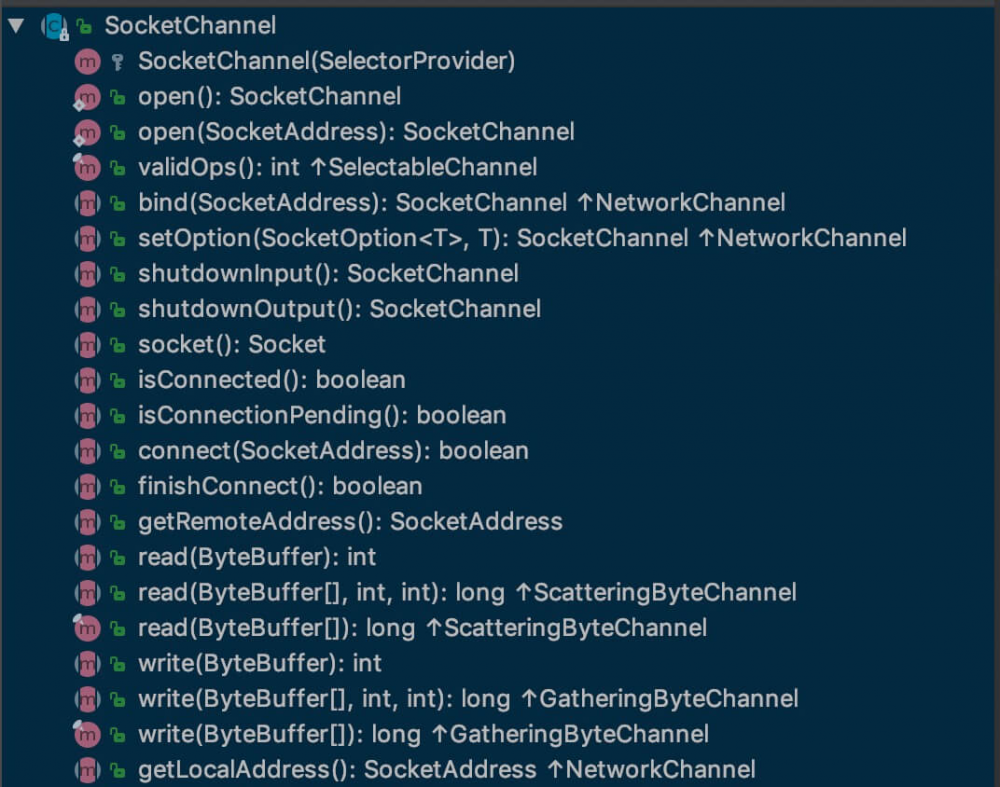
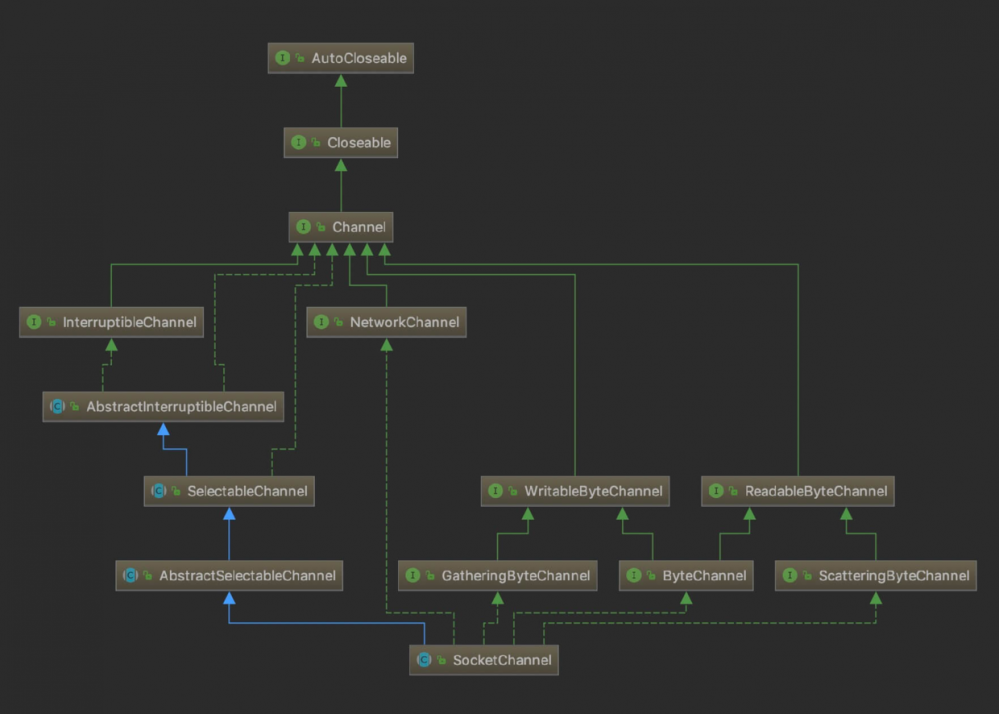
open
/**
* Opens a socket channel.
*
* <p> The new channel is created by invoking the {@link
* java.nio.channels.spi.SelectorProvider#openSocketChannel
* openSocketChannel} method of the system-wide default {@link
* java.nio.channels.spi.SelectorProvider} object. </p>
*
* @return A new socket channel
*
* @throws IOException
* If an I/O error occurs
*/
public static SocketChannel open() throws IOException {
return SelectorProvider.provider().openSocketChannel();
}
open方法是调用SelectorProvider中实现了java.nio.channels.spi.SelectorProvider#openSocketChannel的方法,底层实际是new SocketChannelImpl,调用native方法创建socket
connect
public boolean connect(SocketAddress sa) throws IOException {
//校验Address是否合法
InetSocketAddress isa = Net.checkAddress(sa);
//获取系统安全管理器
SecurityManager sm = System.getSecurityManager();
if (sm != null)
//校验IP和端口是否被允许连接
sm.checkConnect(isa.getAddress().getHostAddress(), isa.getPort());
InetAddress ia = isa.getAddress();
//如果是本机地址,则获取本机的host
if (ia.isAnyLocalAddress())
ia = InetAddress.getLocalHost();
try {
//加读锁
readLock.lock();
try {
//加写锁
writeLock.lock();
try {
int n = 0;
//是否阻塞
boolean blocking = isBlocking();
try {
//开启connect前的校验并设置为ST_CONNECTIONPENDING,如果blocking是true 即阻塞模式,则记录当前线程的ID,以便接收信号处理。
beginConnect(blocking, isa);
do {
//调用native connect方法
n = Net.connect(fd, ia, isa.getPort());
} while (n == IOStatus.INTERRUPTED && isOpen());
} finally {
//结束连接
endConnect(blocking, (n > 0));
}
assert IOStatus.check(n);
return n > 0;
} finally {
//释放写锁
writeLock.unlock();
}
} finally {
//释放读锁
readLock.unlock();
}
} catch (IOException ioe) {
// connect failed, close the channel
close();
throw SocketExceptions.of(ioe, isa);
}
}
configureBlocking
实现自SelectableChannel的接口方法,调用native方法设置socket的阻塞状态
register
在AbstractSelectableChannel中定义,注册要监听的事件。
public final SelectionKey register(Selector sel, int ops, Object att)
throws ClosedChannelException
{
if ((ops & ~validOps()) != 0)
throw new IllegalArgumentException();
if (!isOpen())
throw new ClosedChannelException();
synchronized (regLock) {
if (isBlocking())
throw new IllegalBlockingModeException();
synchronized (keyLock) {
// re-check if channel has been closed
if (!isOpen())
throw new ClosedChannelException();
SelectionKey k = findKey(sel);
if (k != null) {
k.attach(att);
k.interestOps(ops);
} else {
// 向Selector中注册事件
// New registration
k = ((AbstractSelector)sel).register(this, ops, att);
addKey(k);
}
return k;
}
}
}
read
//实现自ReadableByteChannel接口的方法,从socket中读取数据至ByteBuffer
@Override
public int read(ByteBuffer buf) throws IOException {
Objects.requireNonNull(buf);
readLock.lock();
try {
boolean blocking = isBlocking();
int n = 0;
try {
//检查channel是否开启并已经是connected的状态。如果blocking是true 即阻塞模式,则记录当前线程的ID,以便接收信号处理。
beginRead(blocking);
// check if input is shutdown
if (isInputClosed)
return IOStatus.EOF;
//如果是阻塞模式,则一直读取直到数据读取完毕;非阻塞模式则直接调用native方法不需要等待。
if (blocking) {
do {
n = IOUtil.read(fd, buf, -1, nd);
} while (n == IOStatus.INTERRUPTED && isOpen());
} else {
n = IOUtil.read(fd, buf, -1, nd);
}
} finally {
endRead(blocking, n > 0);
if (n <= 0 && isInputClosed)
return IOStatus.EOF;
}
return IOStatus.normalize(n);
} finally {
readLock.unlock();
}
}
//实现自ScatteringByteChannel接口的方法,从socket中依次读取数据至ByteBuffer数组
@Override
public long read(ByteBuffer[] dsts, int offset, int length)
throws IOException
{
Objects.checkFromIndexSize(offset, length, dsts.length);
readLock.lock();
try {
boolean blocking = isBlocking();
long n = 0;
try {
beginRead(blocking);
// check if input is shutdown
if (isInputClosed)
return IOStatus.EOF;
//如果是阻塞模式,则一直读取直到数据读取完毕;非阻塞模式则直接调用native方法不需要等待。
if (blocking) {
do {
n = IOUtil.read(fd, dsts, offset, length, nd);
} while (n == IOStatus.INTERRUPTED && isOpen());
} else {
n = IOUtil.read(fd, dsts, offset, length, nd);
}
} finally {
endRead(blocking, n > 0);
if (n <= 0 && isInputClosed)
return IOStatus.EOF;
}
return IOStatus.normalize(n);
} finally {
readLock.unlock();
}
}
write
//实现自ReadableByteChannel接口的方法,将ByteBuffer中的数据写入socket
@Override
public int write(ByteBuffer buf) throws IOException {
Objects.requireNonNull(buf);
writeLock.lock();
try {
boolean blocking = isBlocking();
int n = 0;
try {
beginWrite(blocking);
//如果是阻塞模式,则一直读取直到数据读取完毕;非阻塞模式则直接调用native方法不需要等待。
if (blocking) {
do {
n = IOUtil.write(fd, buf, -1, nd);
} while (n == IOStatus.INTERRUPTED && isOpen());
} else {
n = IOUtil.write(fd, buf, -1, nd);
}
} finally {
endWrite(blocking, n > 0);
if (n <= 0 && isOutputClosed)
throw new AsynchronousCloseException();
}
return IOStatus.normalize(n);
} finally {
writeLock.unlock();
}
}
@Override
public long write(ByteBuffer[] srcs, int offset, int length)
throws IOException
{
Objects.checkFromIndexSize(offset, length, srcs.length);
writeLock.lock();
try {
boolean blocking = isBlocking();
long n = 0;
try {
beginWrite(blocking);
//如果是阻塞模式,则一直等待直到数据写入完毕;非阻塞模式则直接调用native方法不需要等待。
if (blocking) {
do {
n = IOUtil.write(fd, srcs, offset, length, nd);
} while (n == IOStatus.INTERRUPTED && isOpen());
} else {
n = IOUtil.write(fd, srcs, offset, length, nd);
}
} finally {
endWrite(blocking, n > 0);
if (n <= 0 && isOutputClosed)
throw new AsynchronousCloseException();
}
return IOStatus.normalize(n);
} finally {
writeLock.unlock();
}
}
//实现自ReadableByteChannel接口的方法,将ByteBuffer数组中的数据依次写入socket
/**
* Writes a byte of out of band data.
*/
int sendOutOfBandData(byte b) throws IOException {
writeLock.lock();
try {
boolean blocking = isBlocking();
int n = 0;
try {
beginWrite(blocking);
//如果是阻塞模式,则一直等待直到数据写入完毕;非阻塞模式则直接调用native方法不需要等待。
if (blocking) {
do {
n = sendOutOfBandData(fd, b);
} while (n == IOStatus.INTERRUPTED && isOpen());
} else {
n = sendOutOfBandData(fd, b);
}
} finally {
endWrite(blocking, n > 0);
if (n <= 0 && isOutputClosed)
throw new AsynchronousCloseException();
}
return IOStatus.normalize(n);
} finally {
writeLock.unlock();
}
}
ServerSocketChannel
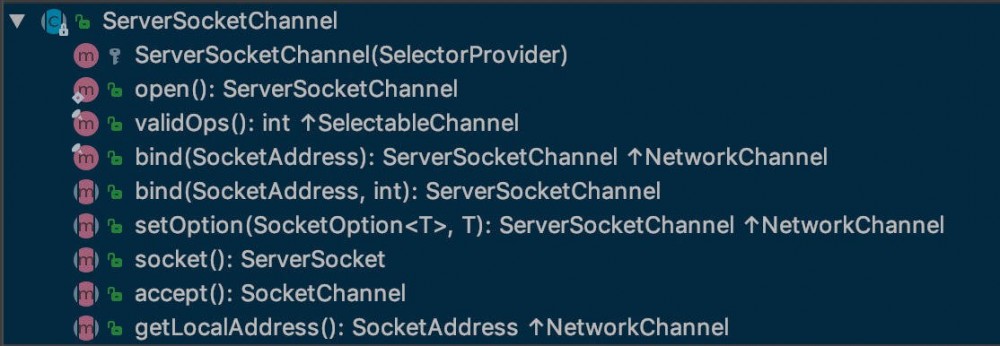

socket
@Override
public ServerSocket socket() {
synchronized (stateLock) {
if (socket == null)
socket = ServerSocketAdaptor.create(this);
return socket;
}
}
bind
@Override
public ServerSocketChannel bind(SocketAddress local, int backlog) throws IOException {
synchronized (stateLock) {
ensureOpen();
if (localAddress != null)
throw new AlreadyBoundException();
InetSocketAddress isa = (local == null)
? new InetSocketAddress(0)
: Net.checkAddress(local);
SecurityManager sm = System.getSecurityManager();
if (sm != null)
sm.checkListen(isa.getPort());
//绑定前做一些前置处理,如将tcp socket文件描述符转换成SDP
NetHooks.beforeTcpBind(fd, isa.getAddress(), isa.getPort());
//绑定IP和地址
Net.bind(fd, isa.getAddress(), isa.getPort());
//开始监听,设置socket上最多可以挂起backlog个连接,若backlog小于1 则默认设置50个
Net.listen(fd, backlog < 1 ? 50 : backlog);
localAddress = Net.localAddress(fd);
}
return this;
}
accept
@Override
public SocketChannel accept() throws IOException {
acceptLock.lock();
try {
int n = 0;
FileDescriptor newfd = new FileDescriptor();
InetSocketAddress[] isaa = new InetSocketAddress[1];
boolean blocking = isBlocking();
try {
begin(blocking);
do {
//阻塞等待接收客户端链接
n = accept(this.fd, newfd, isaa);
} while (n == IOStatus.INTERRUPTED && isOpen());
} finally {
end(blocking, n > 0);
assert IOStatus.check(n);
}
if (n < 1)
return null;
//新接收的socket初始设置为阻塞模式(因此非阻塞模式的每次需要显示设置)
// newly accepted socket is initially in blocking mode
IOUtil.configureBlocking(newfd, true);
InetSocketAddress isa = isaa[0];
//用新接收的socket创建SocketChannel
SocketChannel sc = new SocketChannelImpl(provider(), newfd, isa);
// check permitted to accept connections from the remote address
SecurityManager sm = System.getSecurityManager();
if (sm != null) {
try {
sm.checkAccept(isa.getAddress().getHostAddress(), isa.getPort());
} catch (SecurityException x) {
sc.close();
throw x;
}
}
return sc;
} finally {
acceptLock.unlock();
}
}
ServerSocketChannel并没有read和write方法,只是继承了AbstractSelectableChannel,以便在selector中使用
DatagramChannel
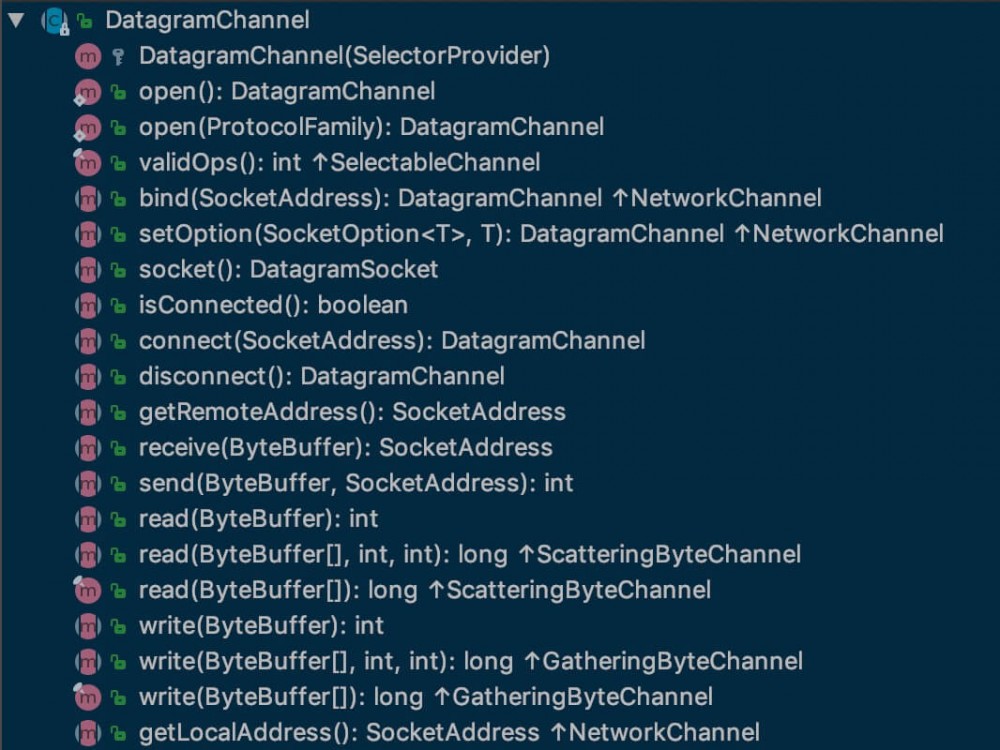
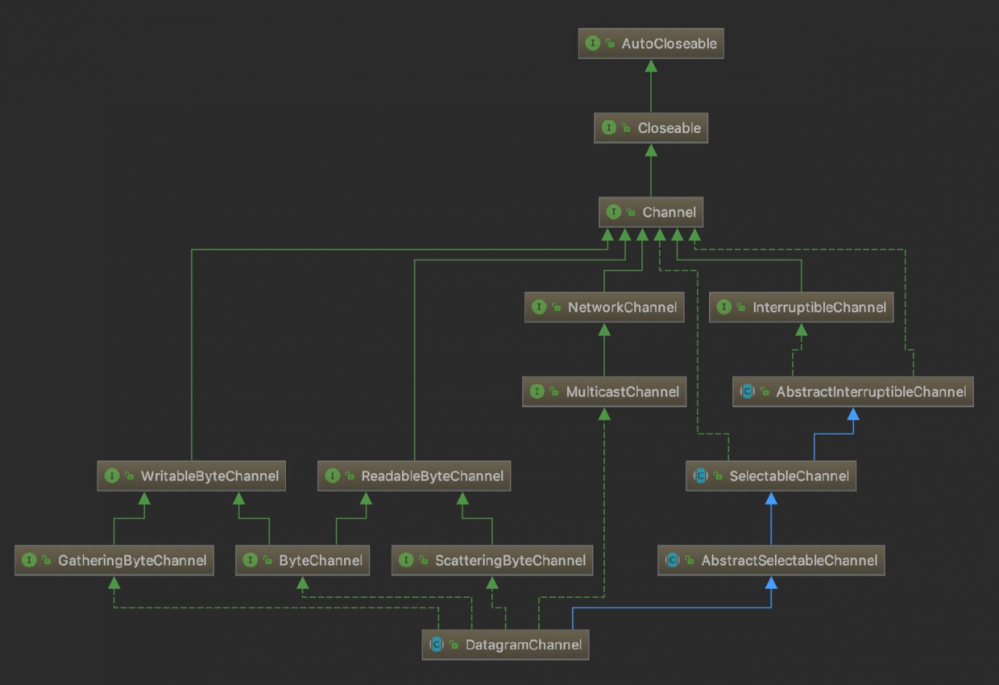
open
public DatagramChannelImpl(SelectorProvider sp)
throws IOException
{
super(sp);
ResourceManager.beforeUdpCreate();
try {
//如果不支持IPv6则使用IPv4
this.family = Net.isIPv6Available()
? StandardProtocolFamily.INET6
: StandardProtocolFamily.INET;
//设置非流式的socket(tcp是流模式协议,udp是数据报模式协议)
this.fd = Net.socket(family, false);
this.fdVal = IOUtil.fdVal(fd);
} catch (IOException ioe) {
ResourceManager.afterUdpClose();
throw ioe;
}
}
receive
public SocketAddress receive(ByteBuffer dst) throws IOException {
if (dst.isReadOnly())
throw new IllegalArgumentException("Read-only buffer");
readLock.lock();
try {
boolean blocking = isBlocking();
int n = 0;
ByteBuffer bb = null;
try {
SocketAddress remote = beginRead(blocking, false);
boolean connected = (remote != null);
SecurityManager sm = System.getSecurityManager();
if (connected || (sm == null)) {
// connected or no security manager
do {
n = receive(fd, dst, connected);
} while ((n == IOStatus.INTERRUPTED) && isOpen());
if (n == IOStatus.UNAVAILABLE)
return null;
} else {
// Cannot receive into user's buffer when running with a
// security manager and not connected
bb = Util.getTemporaryDirectBuffer(dst.remaining());
for (;;) {
do {
n = receive(fd, bb, connected);
} while ((n == IOStatus.INTERRUPTED) && isOpen());
if (n == IOStatus.UNAVAILABLE)
return null;
InetSocketAddress isa = (InetSocketAddress)sender;
try {
sm.checkAccept(isa.getAddress().getHostAddress(),
isa.getPort());
} catch (SecurityException se) {
// Ignore packet
bb.clear();
n = 0;
continue;
}
bb.flip();
dst.put(bb);
break;
}
}
//sender:发送方地址, Set by receive0 (## ugh)
assert sender != null;
return sender;
} finally {
if (bb != null)
Util.releaseTemporaryDirectBuffer(bb);
endRead(blocking, n > 0);
assert IOStatus.check(n);
}
} finally {
readLock.unlock();
}
}
send
public int send(ByteBuffer src, SocketAddress target)
throws IOException
{
Objects.requireNonNull(src);
InetSocketAddress isa = Net.checkAddress(target, family);
writeLock.lock();
try {
boolean blocking = isBlocking();
int n = 0;
try {
//当connect后,remote会设置为连接的地址
SocketAddress remote = beginWrite(blocking, false);
if (remote != null) {
// connected
if (!target.equals(remote)) {
throw new AlreadyConnectedException();
}
do {
n = IOUtil.write(fd, src, -1, nd);
} while ((n == IOStatus.INTERRUPTED) && isOpen());
} else {
// not connected
SecurityManager sm = System.getSecurityManager();
if (sm != null) {
InetAddress ia = isa.getAddress();
if (ia.isMulticastAddress()) {
sm.checkMulticast(ia);
} else {
sm.checkConnect(ia.getHostAddress(), isa.getPort());
}
}
do {
n = send(fd, src, isa);
} while ((n == IOStatus.INTERRUPTED) && isOpen());
}
} finally {
endWrite(blocking, n > 0);
assert IOStatus.check(n);
}
return IOStatus.normalize(n);
} finally {
writeLock.unlock();
}
}
connect
@Override
public DatagramChannel connect(SocketAddress sa) throws IOException {
InetSocketAddress isa = Net.checkAddress(sa, family);
SecurityManager sm = System.getSecurityManager();
if (sm != null) {
InetAddress ia = isa.getAddress();
if (ia.isMulticastAddress()) {
sm.checkMulticast(ia);
} else {
sm.checkConnect(ia.getHostAddress(), isa.getPort());
sm.checkAccept(ia.getHostAddress(), isa.getPort());
}
}
readLock.lock();
try {
writeLock.lock();
try {
synchronized (stateLock) {
ensureOpen();
if (state == ST_CONNECTED)
throw new AlreadyConnectedException();
int n = Net.connect(family,
fd,
isa.getAddress(),
isa.getPort());
if (n <= 0)
throw new Error(); // Can't happen
// connected
remoteAddress = isa;
state = ST_CONNECTED;
// refresh local address
localAddress = Net.localAddress(fd);
// flush any packets already received.
boolean blocking = isBlocking();
if (blocking) {
IOUtil.configureBlocking(fd, false);
}
try {
ByteBuffer buf = ByteBuffer.allocate(100);
while (receive(buf) != null) {
buf.clear();
}
} finally {
if (blocking) {
IOUtil.configureBlocking(fd, true);
}
}
}
} finally {
writeLock.unlock();
}
} finally {
readLock.unlock();
}
return this;
}
udp是数据报模式的协议,是没有connect的。这里的connect实际上是在底层忽略了与其他地址的数据传输。
在connect后,就可以像socketChannel似得使用read和write了
总结
本文学习了各种channel的实现,主要是对底层native方法的一些封装,针对不同属性的实体(文件、socket),使用对应的channel与byteBuffer传输数据。再通过byteBuffer与byte数据进行转换。
channel的实现中,封装了大量的native方法,重要的底层实现全在native中,后续可以深入学习下。
本文中出现的byteBuffer和selector将在接下来的文章中,单独分析。
更多文章见: https://nc2era.com
本文作者:aloof_
阅读原文
本文为云栖社区原创内容,未经允许不得转载。
- 本文标签: UDP 操作系统 example Security equals remote 线程 TCP REST 详细分析 IOS 索引 rand 端口 find list Connection 文章 id UTC tab tar 管理 key provider ACE 服务端 tag 源码 IDE Select 总结 http IO 并发 协议 js 数据 DOM final entity NIO stream java https UI App 锁 src ORM lambda rmi ip 安全 CTO 并发编程 dist Action synchronized 云 db cat
- 版权声明: 本文为互联网转载文章,出处已在文章中说明(部分除外)。如果侵权,请联系本站长删除,谢谢。
- 本文海报: 生成海报一 生成海报二











![[HBLOG]公众号](https://www.liuhaihua.cn/img/qrcode_gzh.jpg)

